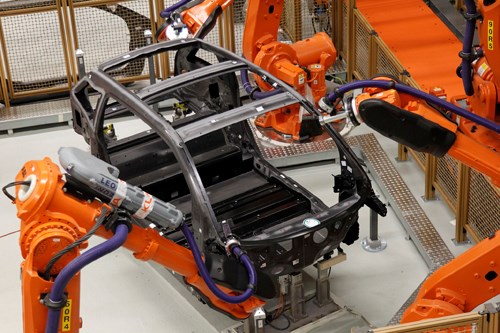The making of the BMW i3
ÂÌñÏ×ÆÞ's tour of the BMW i3 manufacturing and assembly plant in Leipzig, Germany, offers a glimpse of one possible future of automotive production.

The Life Module of the BMW i3 all-electric is comprised of resin transfer molded carbon fiber composite structures that are assembled via robotics at the company's manufacturing and assembly plant in Leipzig, Germany.
The composites industry is full of innovators and creative thinkers, people who move the industry forward incrementally toward greater efficiencies, lower costs and higher quality. But the big material and process leaps the composites community has seen throughout its history have required more than individual expertise. The Chevrolet Corvette or The Boeing Co.’s 787 Dreamliner, for example, is the product of a massive, collective corporate commitment, backed by a capital investment as big, bold and precedent-setting as the envisioned product — a commitment that, to some composites pessimists, appears reckless, hasty, ill-timed and doomed.
Corporate trailblazers are rare, and rarely attempt such leaps without a good command of the materials, processes and technologies required to achieve success. Even so, the risk of doom is real, and redoubles with the size of the enterprise. Missed deadlines and technical setbacks are all the more embarrassing for being so public — and inevitably exploited by naysayers. But at the end of what is, at best, a colossal controlled experiment is the honor and recognition as the first to reach a bold and audacious goal.
Onto this less-traveled corporate road the BMW Group steered when, in 2009, it elected to manufacture an all-electric, four-door passenger car using carbon fiber composites. Originally denoted the MegaCity Vehicle, the commuter car now known as the i3 is designed primarily for urban driving and can travel about 100 miles/160 km on a single charge.
As is widely known by now, the i3 features two primary structures, the aluminum Drive Module – which incorporates the powertrain, chassis, battery, and structural and crash functions – and the Life Module (passenger cell), made from carbon fiber composites. The latter is capped by a composite roof made with recycled carbon fiber, and features a spare but comfortable interior that also incorporates recycled materials and other composites made with natural fiber reinforcements.
We were invited in March to visit the i3 manufacturing and assembly plant in Leipzig, Germany and was offered a chance to see, firsthand, the materials and technologies employed in the creation of this unique vehicle. You will find, in the June issue of Composites Technology magazine, a full report on the facility, materials and processes.
In the meantime, some highlights and impressions from the tour:
- BMW, as might be expected, exerts strict control over the quality of carbon fiber produced and woven for the i3, starting at the SGL Automotive Carbon Fibers plant in Moses Lake, Wash., USA.
- Process control of the resin transfer molding (RTM) process used to make the carbon fiber structures for the Life Module is carefully managed. BMW uses, in Leipzig, seven Schuler presses for RTM, with two KraussMaffei RTM injection units on each press.
- BMW clearly is looking for opportunities to speed up its RTM process, reduce carbon fiber scrap rates and minimize resin usage. Thermoplastics are on the radar.
- The roof of the i3 makes creative use of carbon fiber scrap with the applicaiton of a stitched, nonwoven carbon fiber fabric made by SGL Group.
- Assembly of the Life Module — fully automated by 173 fully articulating ABB robots — is impressive. Only adhesive bonding is used, with no mechanical fasteners.
- BMW, when we visited, was making 70 i3 vehicles per day, which BMW says is on par with expectations — and expected to grow. With the i8 sports car (also with a carbon fiber Life Module) about to start production, the company's RTM throughput will be well tested.
- Driving the i3 is fun (see below image). It's smooth, peppy, quiet and responsive.

ÂÌñÏ×ÆÞ conferences director Scott Stephenson (left) with editor Jeff Sloan (right) in front of the BMW i3 they drove while visiting the BMW Group manufacturing and assembly plant in Leipzig, Germany.
Related Content
Composite resins price change report
CW’s running summary of resin price change announcements from major material suppliers that serve the composites manufacturing industry.
Read MoreAerospace prepregs with braided reinforcement demonstrate improved production rates, cost
A recent time study compares the layup of a wing spar using prepreg with A&P’s TX-45 continuous braided reinforcement versus traditional twill woven prepreg.
Read MoreTechnical textiles, prepregs, composite parts and multilayered materials
CAMX 2025: BGF Industries is highlighting its range of versatile woven products for composite reinforcements, with materials, parts and literature available for viewing, as well as those from parent company Porscher Industries.
Read More3D weaving capabilities achieve complex shapes with reduced labor times, costs
JEC World 2025: The specialized engineered woven fabrics company displays film-infused 3D woven joints, woven TPS and woven composite 3D structures.
Read MoreRead Next
Scaling up, optimizing the flax fiber composite camper
Greenlander’s Sherpa RV cab, which is largely constructed from flax fiber/bio-epoxy sandwich panels, nears commercial production readiness and next-generation scale-up.
Read MoreUltrasonic welding for in-space manufacturing of CFRTP
Agile Ultrasonics and NASA trial robotic-compatible carbon fiber-reinforced thermoplastic ultrasonic welding technology for space structures.
Read MoreCeramic matrix composites: Faster, cheaper, higher temperature
New players proliferate, increasing CMC materials and manufacturing capacity, novel processes and automation to meet demand for higher part volumes and performance.
Read More












